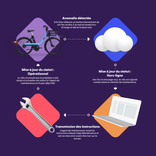Typical use case - solving pedal assist inefficiency
It goes without saying that one of the most important aspects of an electric bike is that the pedal assist feature runs efficiently. One of the things we are able to do at Fifteen is detect that the chain tension is too high, which impacts the assistance and makes for sub-optimal performance.
Depending on how the operations system is set up, the vehicle can either stay in service and continue to monitor the tension, or take itself offline and flag itself to be checked by a field technician immediately.
This is a huge benefit because not only does it ensure riders have great experiences, but it also allows the bikes to be seen before the chain tension leads to a worse fault that stops the bike from being used completely.
Other examples
- Battery - does the battery show signs of physical or water damage? Is it becoming too hot or cold to operate effectively?
- Mechanical - reporting on the status and effectiveness of brakes, motor etc.
- Connectivity - are there connection interruptions to BLE, WiFi or LTE-M?
- Software - has battery consumption increased since the latest firmware update? Electrical - is the bike unlocking and locking properly, and is it transferring power to the other bikes in the station?
Using all the data you can also identify what problems you are likely to face in the future and plan accordingly. Perhaps this means you adjust the number of field agents you have out on any one day, or change their locations or priorities.
One thing is certain, this data will help you maintain high fleet availability, increase your rides and, therefore, increase revenue. The self-diagnosis features will also cut your operational costs, because field agents will take to the streets already knowing what the problems are, equipped with the right tools.
Optimizing field operations
Self-diagnosis signals play a crucial role in optimizing maintenance operations during the day, and even the following day. If field agents know what the problems are without having to work them out on site, they can come equipped to the location with the right tools and fix the issue with minimal fuss. This saves a considerable amount of time.
It also means that the team knows, before they even start their round, which vehicles are quick-fixes and which ones will need to go back to the warehouse. Vehicles with minor problems can be prioritized, contributing to increased fleet availability and increasing daily ridership.
The low-down
- Detecting potential issues before they become a reality has a significant impact on user experience.
- Knowing what to solve up-front allows field agents to be better organized and optimize their routes - which can also contribute to improved workforce management and lower operational costs.
- More fixed vehicles means more ridership, contributing simultaneously to user acquisition and retention!




